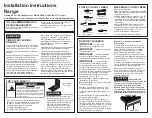
NOTICE
-
This service data sheet is intended for use by persons having electrical and mechanical training and a level of
knowledge of these subjects generally considered acceptable in the appliance repair trade. The manufacturer cannot be
responsible, nor assume any liability for injury or damage of any kind arising from the use of this data sheet.
SAFE SERVICING PRACTICES
To avoid the possibility of personal injury and/or property damage, it is important that safe servicing practices be observed. The following
are examples, but without limitation, of such practices.
1.
Before servicing or moving an appliance remove power cord from electrical outlet, trip circuit breaker to OFF, or remove fuse.
2.
Never interfere with the proper installation of any safety device.
3.
GROUNDING: The standard color coding for safety ground wires is
GREEN
or
GREEN WITH YELLOW STRIPES
. Ground leads are
not to be used as current carrying conductors.
It is extremely important that the service technician reestablish all safety
grounds prior to completion of service. Failure to do so will create a potential safety hazard.
4.
Prior to returning the product to service, ensure that:
• All electric connections are correct and secure.
• All electrical leads are properly dressed and secured away from sharp edges, high-temperature components, and moving parts.
• All uninsulated electrical terminals, connectors, heaters, etc. are adequately spaced away from all metal parts and panels.
• All safety grounds (both internal and external) are correctly and securely reassembled.
Oven Calibration
Set the electronic oven control for normal baking at 350°F. Obtain an average oven temperature after a minimum of 5 cycles. Press
STOP
or
CLEAR
keypad to end Bake mode.
Temperature Adjustment
1.
While in a non-cooking mode, press and hold the
BAKE
key pad for 6 seconds.
2.
The current calibration offset (temperature adjustment) should appear in the temperature display.
3.
Use the number key pads (0-9) to enter the desired amount of adjustment (up to 35°F).
4.
Press
SELF CLEAN
key pad to change the sign of the adjustment to a (-) if necessary. A positive adjustment will not display a sign.
5.
Once the desired adjustment (-35° to 35° F) has been entered, press the
START
key pad to accept the change or the
STOP/CLEAR/
CANCEL
key pad to reject the change.
Note:
Changing calibration affects all Baking modes. The adjustments made will not change the self-cleaning temperature.
RTD SCALE
Temperature (°F)
Resistance (ohms)
32 ± 1.9
1000 ± 4.0
75 ± 2.5
1091 ± 5.3
250 ± 4.4
1453 ± 8.9
350 ± 5.4
1654 ± 10.8
450 ± 6.9
1852 ± 13.5
550 ± 8.2
2047 ± 15.8
650 ± 9.6
2237 ± 18.5
900 ± 13.6
2697 ± 24.4
SERVICE DATA SHEET
Electric Range with ES 540 Electronic Oven Control
p/n 316905028 (0907) En
Electronic Oven Control & Jumper Connections (EOC Rear View)
Runaway Temperature.
Shorted Keypad.
Bad Micro Identification.
Bad EEPROM Identification/Checksum error.
Communication failure between EOC & ESEC system
(for electric range models ONLY)
Communication failure with Mini Oven Control Board.
(for models equipped with Bake-n-Warm™ ONLY)
Shorted Probe connection.
Maximum oven door unlock time exceeded.
Maximum oven door unlock attempts exceeded.
Maximum oven door open time exceeded.
Maximum oven door lock time exceeded.
Maximum oven door lock attempts exceeded.
Door Latch
Likely Failure Condition/Cause
Suggested Corrective Action
Fault Code
1. (F10 only) Check RTD Sensor Probe & replace if necessary. If oven is overheating, disconnect
power. If oven continues to overheat when the power is reapplied, replace EOC. Severe
overheating may require the entire oven to be replaced should damage be extensive.
2. (F11, 12 & 13) Disconnect power, wait 30 seconds and reapply power.
3. (F11, 12 & 13) If fault returns upon power-up, replace EOC.
1. Test harness/connections P4 (EOC) & P7 (Surface Element Control Board)
2. If harness checks O.K. failure can be caused by faulty UIB, Surface Element Control Board
or EOC.
1. Check harness & connectors from the EOC to Mini Oven Control Board. Check for 15VDC
to Mini Oven Control Board (red & gray wires). If harness and voltage are good replace Mini Oven
Control Board. If fault returns replace the EOC.
1. (F30 or F31) Check resistance at room temperature & compare to RTD Sensor resistance chart.
If resistance does not match the RTD chart replace RTD Sensor Probe. Check Sensor wiring
harness between EOC & Sensor Probe connector.
2. (F30 or F31) Check resistance at room temperature, if less than 500 ohms, replace RTD Sensor
Probe. Check for shorted Sensor Probe harness between EOC & Probe connector.
1. (F90) Check the wiring between EOC & Lock Motor Micro Switch.
2. (F90) Replace the Motor Door Latch assembly if necessary.
3. (F90) Check for binding of the Latch Cam, Lock Motor Rod & Lock Motor Cam.
4. (F90) Check to see if Lock Motor Coil is open. If open, repl;ace Lock Motor Assembly.
5. (F90)Lock Motor continuosly runs - if Micro Switch is open, replace Lock Motor Assembly.
6. (F90) Check oven door Light Switch - if open, replace Switch.
7. If all situations above do not solve probem, replace EOC.
F10
F11
F12
F13
F20
F26
F30
F31
F90
F91
F92
F93
F94
F95
Resistance Temperature Detector (RTD)
Resistance Temperature Detector Scale
Electonic Oven Control Fault Code Descriptions
Circuit Analysis Matrix
IMPORTANT
DO NOT REMOVE THIS BAG
OR DESTROY THE CONTENTS
WIRING DIAGRAMS AND SERVICE
INFORMATION ENCLOSED
REPLACE CONTENTS IN BAG
L1
WARMER DRAWER
CONV. ELEMENT
(some models)
CONV. FAN






















